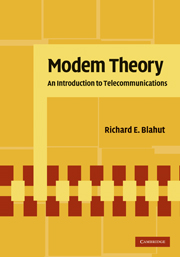Book contents
- Frontmatter
- Contents
- Preface
- Dedication
- 1 Introduction
- 2 Baseband Modulation
- 3 Baseband Demodulation
- 4 Sequences at Baseband
- 5 Passband Modulation
- 6 Passband Demodulation
- 7 Principles of Optimal Demodulation
- 8 Synchronization
- 9 Codes for Digital Modulation
- 10 Codes for Data Transmission
- 11 Performance of Practical Demodulators
- 12 Secure Communications
- Bibliography
- Index
1 - Introduction
Published online by Cambridge University Press: 05 June 2012
- Frontmatter
- Contents
- Preface
- Dedication
- 1 Introduction
- 2 Baseband Modulation
- 3 Baseband Demodulation
- 4 Sequences at Baseband
- 5 Passband Modulation
- 6 Passband Demodulation
- 7 Principles of Optimal Demodulation
- 8 Synchronization
- 9 Codes for Digital Modulation
- 10 Codes for Data Transmission
- 11 Performance of Practical Demodulators
- 12 Secure Communications
- Bibliography
- Index
Summary
A point-to-point communication system transfers a message from one point to another through a noisy environment called a communication channel. A familiar example of a communication channel is formed by the propagation of an electromagnetic wave from a transmitting antenna to a receiving antenna. The message is carried by the time-varying parameters of the electromagnetic wave. Another example of a communication channel is a waveform propagating through a coaxial cable that connects a jack mounted on an office wall to another such jack on another wall or to a central node. In these examples, the waveform as it appears at the receiver is contaminated by noise, by interference, and by other impairments. The transmitted message must be protected against such impairments and distortion in the channel. Early communication systems were designed to protect their messages from the environment by the simple expedient of transmitting at low data rates with high power. Later, message design techniques were introduced that led to the development of far more sophisticated communication systems with much better performance. Modern message design is the art of piecing together a number of waveform ideas in order to transmit as many bits per second as is practical within the available power and bandwidth. It is by the performance at low transmitted energy per bit that one judges the quality of a digital communication system. The purpose of this book is to develop modern waveform techniques for the digital transmission of information.
- Type
- Chapter
- Information
- Modem TheoryAn Introduction to Telecommunications, pp. 1 - 30Publisher: Cambridge University PressPrint publication year: 2009



